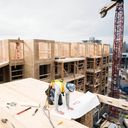There's a growing movement to build wooden skyscrapers

The "mass timber" movement is a growing worldwide effort to build high-rises and other buildings out of wood composites rather than steel and concrete, for environmental reasons.
Why it matters: Lightweight, attractive and sturdy, mass timber buildings are considered carbon-friendly alternatives to conventional ones — and some people prefer their warmth, character and texture.
- A recent international building code change means that mass timber structures can rise to 18 stories — unless you get a variance to go higher.
- Vox calls mass timber "the hottest thing in architecture this century," saying it "amounts to 'wood, but like Legos.'"
How it works: Mass — or "massive" — timber is "wood that is glued and pressed in special ways to make it similar in strength to concrete and steel and thus capable of replacing those building materials even for skyscrapers and other massive edifices," per the WSJ.
- You still need steel and concrete for the foundation and other elements.
- And if you're wondering about the fire risk, it's minimal — because "unlike wood planks or beams cut from individual trees, the massive blocks of engineered timber used in large-scale construction projects do not burn through: they char only on the surface," The New Yorker tells us.
Driving the news: While Europe has embraced the mass timber movement, the U.S. is starting to catch up.
- In October, the New York City Council approved the use of mass timber for buildings up to 85 feet tall — six or seven stories.
- An 80-story wooden tower called the River Beech project is proposed for Chicago.
- Carbon12, an eight-story condominium building in Portland, Oregon, made of cross-laminated timber (CLT), was in the vanguard when it opened in 2018.
- When it's finished this summer, Ascent, a 25-story apartment tower in Milwaukee, "will be the world’s tallest mass timber structure (284 feet), surpassing Mjøstårnet in Brumunddal, Norway (277 feet)," according to Building Design + Construction magazine (BD+C).
What they're saying: Advocates say mass timber "creates less waste, leaves a lighter carbon footprint (because wood sequesters carbon), and can be quicker and quieter than other construction modes," per BD+C.
- "Some go so far as to claim that exposed wood has tangible health and wellness benefits for building occupants."
The other side: Detractors question "whether the logging and manufacturing required to produce the new material outweigh any benefits," journalist Jim Robbins writes for the Yale School of the Environment.
Tallest so far: The 18-story Mjøstårnet — or Mjösa Tower — opened in 2019 and includes office space, apartments and a 72-room hotel.
- "The first ten floors are made of prefabricated wooden elements," per the Boston Real Estate Times. "The decks on the upper floors are made of concrete, to restrain the building and keep it from swaying."
- Mjøstårnet "is an audacious gesture and a proof of concept," says a recent takeout in The New Yorker. "It depends for its strength and stability not on steel and concrete but on giant wooden beams."
What's next: Expect to see lots of mass timber buildings rising in cities across the U.S. — apartment towers and office complexes — and marketed as "green."